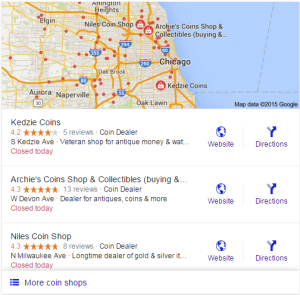Every year the very talented David Mihm releases a survey called the “Local Search Ranking Factors.” Mr. Mihm surveys some of the best minds in the industry and compiles a report to help all of us learn how the local space is changing, what is working and what could cause your business trouble.
The one constant year after year is that local search marketing evolves and this year is no different. The advent of the Snack Pack, the evolution of the Pigeon update from a year ago and the disappearance of Google+ makes this a very interesting year indeed.
In case you don’t have time to review everything from the report published on Moz.com, we at Evolving Interactive wanted to highlight some of the main points of the survey and give you some insight into the major changes discussed in this year’s report.
What’s Important?
According to the experts surveyed, the most important components to a strong local search marketing campaign are building quality links and improving domain authority. This might sound a lot like a typical SEO campaign to a lot of you. Phil Rozek agrees, saying, “In the past year or so, “local” seems to have come full-circle: it’s mostly organic SEO (read: links).”
The other key component that Evolving Interactive felt was underrated by the survey is “Quality/Authority of Structured Citations.” By “citations” we are talking about local directory websites or industry specific sites that list your business (i.e. Yelp, CitySearch, etc). Evolving Interactive has been able to help websites with little link authority rank in the local section quickly by building citations and making sure that those citations are consistent on all sites.
What hurts your rankings?
A lot of things that will hurt your local campaign are fairly commonsensical. The top “Negative Ranking Factor” was selecting the incorrect business category. It might surprise you to learn how often this mistake happens to campaigns we inherit. Before any of this advice will be helpful, we recommend that you review the Google My Business Guidelines. It’s so easy to avoid mistakes like having an address at a P.O. Box as long as you understand the rules.
Evolving Interactive also thinks it’s important to do some on-page work to help your Local Search Marketing campaign. Four of the top 10 Negative Ranking Factors have to do with mismatched NAP (name, address, phone number) either on your website’s home page, Google My Business page, or the absence of NAP data in a crawlable fashion on your home page. Contact us if you have any questions about entering this information properly.
What is the Snack Pack?
In August, Google made a significant change to their local algorithm. Instead of showing 7 results, they are now showing only 3. That wasn’t the only significant change. The snack pack marked the end of Google+ as it relates to local search. Prior to this change, Google’s search engine results page showed a link to the business’ Google+ page in the local results. That link is now removed. Interestingly, the phone number is also missing from the local results for desktop users.
This is a major change that has sparked a lot of discussion. The experts in the Local Search Ranking factors were asked about this change. Joy Hawkins explains, “With Google getting rid of links to the G+ pages for most SERPs, the push for businesses to be more active on G+ has really died down.“
Miscellaneous Takeaways
The most important thing we think a local business can do is to accurately fill out your Google My Business profile, include NAP on the pages of your website, build consistent citations on other websites, and then build links with good anchor text.
As always if you have any questions or concerns, please contact us at info@evolvinginteractive.com.







